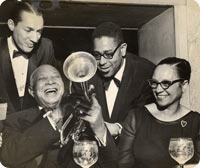Journalist and Critic
Feather is best known as a jazz journalist and critic. He wrote throughout his life for a variety of publications, including Downbeat and Esquire, before moving to California and becoming a regular jazz columnist for The Los Angeles Times. His column for The Los Angeles Times was syndicated to over 500 newspapers. Feather's signature contribution were the blindfold tests, in which participants gave their opinions of music after listening to a performance without knowledge of who created the recording. The blindfold tests helped to dispel many misconceptions related to race and gender, or even the notion that studio men were not capable of improvising.

